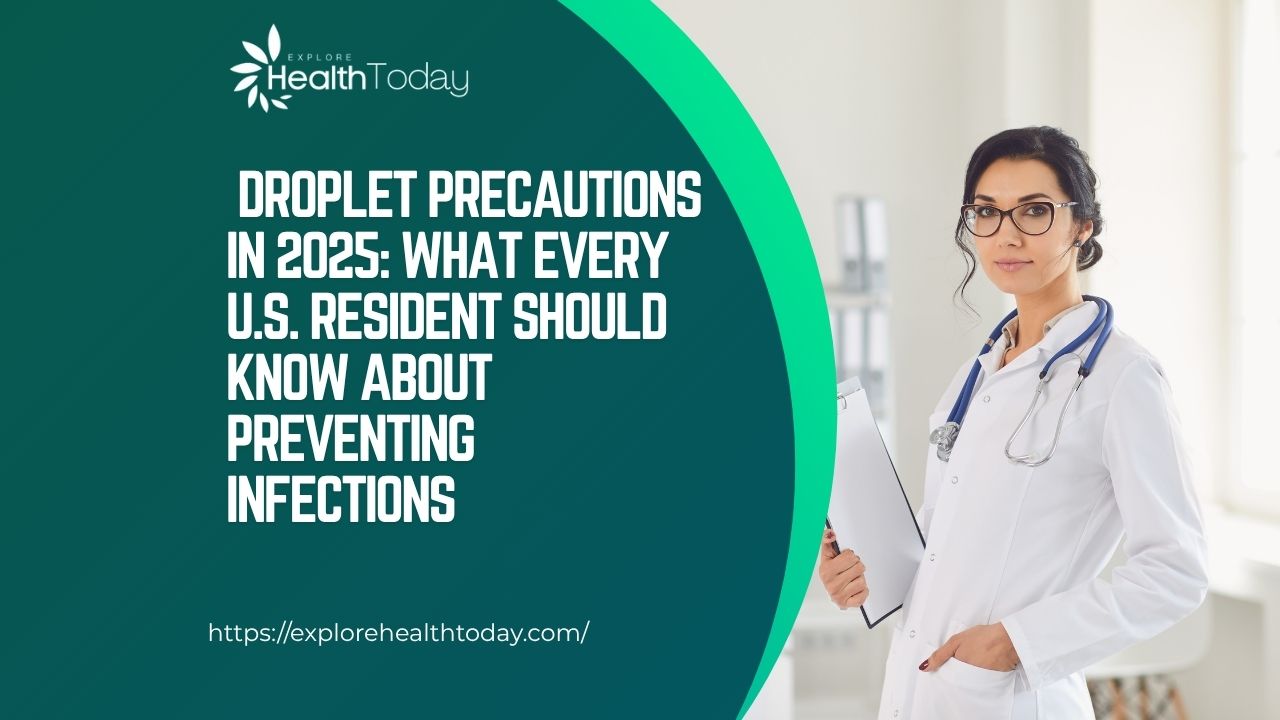From seasonal flu to COVID-19, the spread of respiratory illnesses continues to pose a threat across the United States. One of the most effective ways healthcare providers and individuals help stop the spread of these illnesses is by using droplet precautions—a set of infection control practices designed to prevent the transmission of infectious agents through respiratory droplets.
In this article, we’ll break down exactly what droplet precautions are, how they work, when they should be used, and how 2025 public health guidelines are shaping infection control in both healthcare and community settings.
What Are Droplet Precautions?
Droplet precautions are a form of infection control used to prevent the spread of pathogens that are transmitted through respiratory droplets. These droplets are typically released when an infected person coughs, sneezes, talks, or breathes heavily. They can travel short distances—usually up to six feet—and infect someone who inhales them or touches contaminated surfaces.
Diseases Commonly Requiring Droplet Precautions
- Influenza (Flu)
- COVID-19
- Respiratory Syncytial Virus (RSV)
- Mumps
- Pertussis (Whooping Cough)
- Meningococcal meningitis
According to the Centers for Disease Control and Prevention (CDC), droplet precautions are a standard part of their transmission-based precautions and are especially important in hospital and long-term care settings.
Why Droplet Precautions Matter in 2025
As of 2024–2025, the U.S. is still seeing seasonal spikes in respiratory illnesses. The 2024–2025 flu season alone has already caused an estimated 450,000 hospitalizations, while COVID-19 continues to circulate at lower but still significant levels. Public health experts are urging increased vigilance, especially in healthcare settings, nursing homes, and during travel.
Key 2025 Trends in Infection Control
- Updated CDC guidance emphasizes flexibility in masking based on transmission rates.
- Nursing homes and hospitals now require mandatory training on droplet precautions for all staff.
- Schools and daycare centers are incorporating droplet control education into health curriculums.
These trends reflect the growing understanding that droplet-borne infections can be managed effectively with layered precautions—but only if everyone does their part.
Core Elements of Droplet Precautions
1. Masking
Wearing a surgical mask is essential when entering the room of a person on droplet precautions. The infected individual should also wear a mask if they must leave their room.
- Healthcare providers and visitors must mask before entry.
- The patient should wear a mask when around others.
2. Isolation
Patients with a droplet-spread illness should be placed in a private room, or if necessary, cohorted with another patient who has the same infection.
- The door may remain open unless combined with airborne precautions.
- Room signage should clearly indicate “Droplet Precautions.”
3. Hand Hygiene
Strict adherence to handwashing is critical before and after contact with a patient or their environment.
- Use soap and water or a CDC-approved alcohol-based hand sanitizer.
- Avoid touching the face after removing a mask or gloves.
4. Use of Personal Protective Equipment (PPE)
While droplet precautions focus on masks, gloves and gowns may also be used depending on the situation.
- Especially important when close contact or bodily fluids are involved.
- PPE should be removed and disposed of before exiting the room.
Who Should Use Droplet Precautions?
In Healthcare Settings
All healthcare workers—including nurses, physicians, therapists, and technicians—should implement droplet precautions when treating patients with suspected or confirmed respiratory infections.
In Long-Term Care Facilities
Given the high vulnerability of residents, facilities must:
- Educate staff and residents on droplet precautions
- Isolate symptomatic individuals quickly
- Provide PPE stations outside resident rooms
According to CMS 2025 regulations, all Medicare- and Medicaid-certified facilities must document compliance with infection control policies—including proper use of droplet precautions.
In Schools and Daycares
While not always labeled as “droplet precautions,” schools often implement similar steps:
- Encouraging sick students to stay home
- Promoting proper cough etiquette and handwashing
- Isolating symptomatic students until pickup
For updated school guidelines, visit the U.S. Department of Education’s health resource page.
Droplet Precautions vs. Airborne Precautions: What’s the Difference?
It’s easy to confuse droplet precautions with airborne precautions, but they apply to different transmission types.
| Precaution Type | Transmission Range | Examples | Protective Measures |
| Droplet | ~6 feet | Flu, COVID-19, RSV | Surgical masks, private rooms |
| Airborne | >6 feet and long-distance suspension | Tuberculosis, Measles, Chickenpox | N95 masks or respirators, negative pressure rooms |
Understanding the distinction is important for choosing the correct infection control method.
U.S. Laws and Standards in 2025
Several federal and state-level standards now require institutions to adopt droplet precautions under certain conditions:
- OSHA’s General Duty Clause mandates a safe work environment, including infection control.
- CDC’s updated Isolation Precautions Guidelines (revised for 2025) highlight the need for real-time adjustments during outbreaks.
- Joint Commission Accreditation Requirements assess hospitals on their infection prevention readiness, including proper signage, PPE usage, and staff compliance.
Facilities failing to follow these standards risk citations and loss of funding.
How to Practice Droplet Precautions at Home
In some cases—like caring for a sick child or partner—you may need to apply droplet precautions in your own home.
At-home strategies include:
- Keeping the sick person in a separate room
- Wearing a mask when providing care
- Disinfecting commonly touched surfaces (doorknobs, remote controls, faucets)
- Ensuring proper ventilation in shared spaces
- Washing hands frequently and thoroughly
If you’re unsure whether droplet precautions apply, consult your healthcare provider or refer to the CDC’s home care guidance.
Common Mistakes to Avoid
Even well-meaning individuals and organizations sometimes misuse or misunderstand droplet precautions.
Top Mistakes
- Using cloth masks instead of surgical masks in clinical settings
- Failing to isolate the infected individual properly
- Not changing PPE between patients
- Improper hand hygiene technique or duration
- Touching the front of the mask when removing it
Proper training and refreshers are critical—especially in fast-paced environments like hospitals and schools.
Conclusion
Droplet precautions are a proven, practical method for preventing the spread of infectious diseases. As we continue to face new and recurring respiratory illnesses in 2025, it’s more important than ever to understand how these precautions work and when to use them.
Whether you’re a healthcare professional, educator, or concerned parent, mastering the basics of droplet precautions helps keep you, your family, and your community safer. With proper application and a commitment to hygiene, we can break the chain of infection and reduce the impact of contagious diseases across the country.
Do your part in preventing the spread of infection—at work, school, or home. Learn more about droplet precautions and share this information with your community. For the latest public health updates, visit the CDC or your local health department.
About ExploreHealthToday.com
ExploreHealthToday.com was created to be a one-stop resource where readers can find up-to-date, well-researched articles on a variety of health topics. From nutrition and wellness to lifestyle and mental health, we strive to provide reliable information to help you make informed decisions about your well-being.
We believe that good health starts with good information, and our mission is to empower our readers with knowledge they can trust.
Visit us at ExploreHealthToday.com to learn more.





